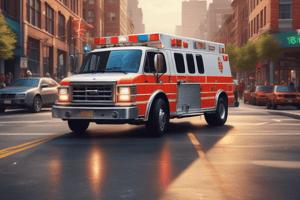Podcast
Questions and Answers
What type of bleeding is characterized by dark red blood flowing steadily from a wound?
What type of bleeding is characterized by dark red blood flowing steadily from a wound?
Venous
Given a male patient with arterial bleeding from a knife wound, what do you expect?
Given a male patient with arterial bleeding from a knife wound, what do you expect?
- Bright red blood that is spurting with each beat of the heart (correct)
- Brownish red blood oozing
- No blood visible
- Dark red blood flowing steadily
What occurs when edema of the extremity compromises nervous function and circulation?
What occurs when edema of the extremity compromises nervous function and circulation?
Compartment syndrome
What is it called when a flap of skin has been torn away without being completely removed?
What is it called when a flap of skin has been torn away without being completely removed?
Which condition is presented by black-and-blue discoloration of the skin?
Which condition is presented by black-and-blue discoloration of the skin?
What type of injury occurs when the skin of one hand has been completely torn away?
What type of injury occurs when the skin of one hand has been completely torn away?
What should be used to dress thermal burns to the eyes?
What should be used to dress thermal burns to the eyes?
If a patient has dry red skin without blistering from a flash fire, how would you classify his burns?
If a patient has dry red skin without blistering from a flash fire, how would you classify his burns?
What is a major concern for a patient with burns developing hoarseness and blisters?
What is a major concern for a patient with burns developing hoarseness and blisters?
What is NOT a burn center referral criterion?
What is NOT a burn center referral criterion?
What does the epidermis serve as?
What does the epidermis serve as?
What function does the subcutaneous layer of the skin assist with?
What function does the subcutaneous layer of the skin assist with?
Which burn classification describes a first-degree burn?
Which burn classification describes a first-degree burn?
How can you differentiate a partial-thickness burn from a superficial burn?
How can you differentiate a partial-thickness burn from a superficial burn?
Why is the rule of nines used in assessing burns?
Why is the rule of nines used in assessing burns?
Using the rule of nines, what percentage of burn does a patient with anterior chest and circumferential burns to both lower extremities have?
Using the rule of nines, what percentage of burn does a patient with anterior chest and circumferential burns to both lower extremities have?
What approximately percentage of the body is burned when a patient has burns to the entire anterior chest, abdomen, neck, and face?
What approximately percentage of the body is burned when a patient has burns to the entire anterior chest, abdomen, neck, and face?
When is the rule of palm best used?
When is the rule of palm best used?
What type of burns does a patient with severely burned hands that are charred and black, along with pain and blistering, have?
What type of burns does a patient with severely burned hands that are charred and black, along with pain and blistering, have?
Which of the following would be classified as a moderate burn?
Which of the following would be classified as a moderate burn?
Flashcards are hidden until you start studying
Study Notes
Types of Bleeding
- Venous bleeding presents with dark red blood flowing steadily from a wound.
- Arterial bleeding is characterized by bright red blood that spurts with each heartbeat.
Injury Complications
- Compartment syndrome occurs when edema compresses nerves and circulation in an extremity, compromising function.
Wound Types
- Partial avulsion refers to a flap of skin that is torn away but not completely removed.
- An avulsion involves complete tearing away of skin.
Bruising and Skin Injuries
- A contusion is identified by black-and-blue discoloration or bruising of the skin.
Burn Assessment
- Dry sterile dressings are recommended for thermal burns to the eyes.
- Superficial burns are characterized by dry, red skin without blistering.
Fire-Related Injuries
- Major concern in burn patients may include inhalation injury, especially in cases of smoke exposure.
- Referral to a burn center is not typically required for superficial burns covering 10% or less of body surface area.
Skin Layers and Functions
- The epidermis acts as a barrier between the body and the external environment.
- The subcutaneous layer aids in body temperature regulation.
Burn Classifications
- First-degree burns are classified as superficial burns, while partial-thickness burns present blisters.
- The rule of nines allocates approximately 9% for identifying body surface areas affected by burns.
Calculating Burn Area
- A patient with blisters on the chest and circumferential burns on the lower extremities may have around 45% body surface area burned.
- Burns covering the entire anterior chest, abdomen, neck, and face total approximately 27% of the body.
- The rule of palm can be effectively used to estimate burn areas when they are smaller.
Severity of Burns
- Patients with both partial- and full-thickness burns present severe injuries, especially if exhibiting white and charred burns with pain and blistering.
- Moderate burns are classified as partial-thickness burns.
Studying That Suits You
Use AI to generate personalized quizzes and flashcards to suit your learning preferences.




